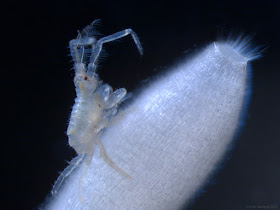Meet the amphipod Podocerus spongicolus! This tiny amphipod is only 3-4 mm long. Notice its very long 2nd
antennae. The amphipods cling tightly to
the outer wall of the sponge with the pointy tips (dactyls) of their thoracic
appendages. In the photo below, you can also see
the shiny calcareous skeletal elements (spicules) shining through the body wall
of the sponge:
This amphipod can be distinguished from other Podocerus
species by the fact that article 4 (A4) of the male gnathopod (feeding
appendage) is extended forward (see arrow in left figure below). The photo on the right shows
this same feature in the live amphipod:
As its name indicates, Podocerus spongicolus is known to be
associated with sponges. Otherwise, it appears that little is known about this
species. We have only been able to find
a few museum records of this amphipod (from the 1930s and 1960s).
It is interesting to think about its life among the sponges. Many thanks to Maddy and Michael for spotting these amphipods, Collin for identifying them, and Eric for taking the photographs!




Back in 1975 my project for Marine Biology was looking into loggerhead sponges (Spheciospongia vesparium) at Bimini in the Caribbean) and see who lived inside. Lots of critters! Isopods, brittle stars, snapping shrimp (Alpheus). It was cool! Until one evening I forgot to wear gloves and got spicules in my fingers. Ouch! It was like fiberglass. I couldn't even hold silverware that night.
ReplyDeleteFascinating! Great detective work on all fronts. As always, thanks for sharing this little gem.
ReplyDelete